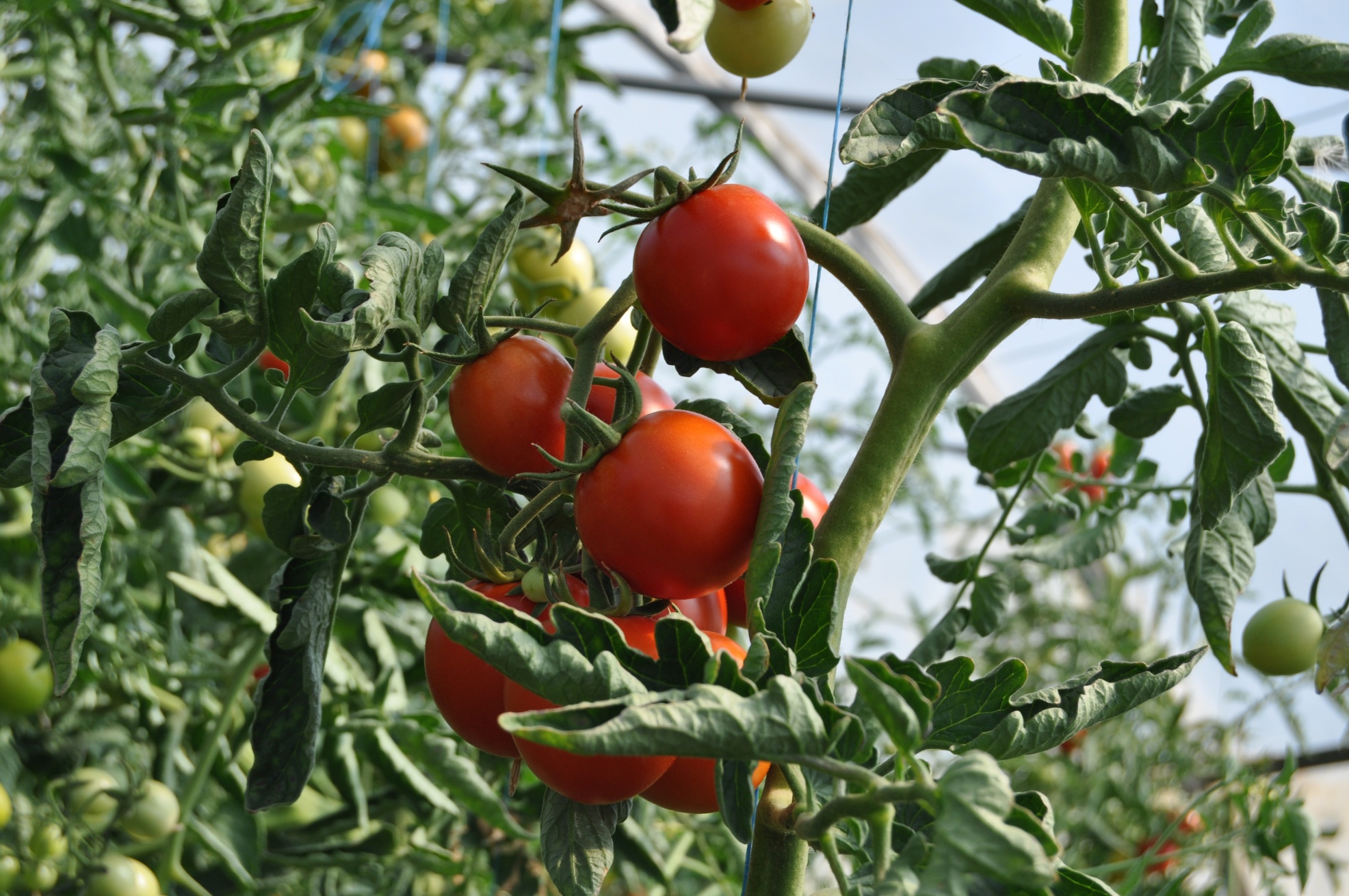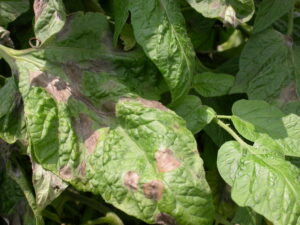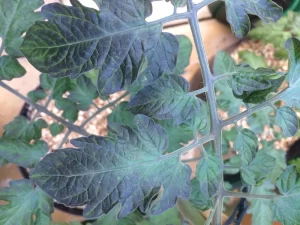If you have grown tomatoes, chances are they have experienced leaf curl, a rolling of the leaves in either an upward or downward direction or sometimes in a more contorted way. The question is, why does this happen? There are numerous reasons why this can occur. In this post, we will look at the top 10 reasons so you can better diagnose leaf curl in your garden.
1. Environmental Stress – Upward Leaf Curl
The most common causes of upward leaf curl are environmental stressors. Leaves act as solar panels to collect energy for the plant. When conditions are too dry, too hot, or too windy, the leaves will curl upwards to reduce their surface area. This is sometimes referred to as physiological leaf roll.
Lower, and therefore older, leaves will experience this first followed by younger leaves. As a result, curled leaves will absorb less heat and slow down the transpiration rate, conserving moisture. (Transpiration is the movement of water throughout the plant. Water transpires or exits via stomates on the leaves.)
Leaf curl may still occur even though the plant is receiving adequate water. The problem is not because it isn’t receiving water, but due to excessive heat or wind, it is losing moisture faster than it can absorb it.
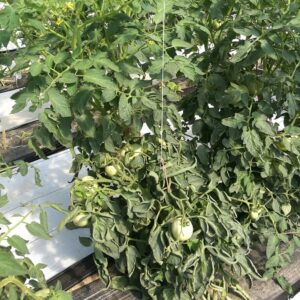
Conversely, a plant that is being overwatered, or experiencing excessively moist or cool conditions, may respond by developing leathery leaves with an upward curl. This is a protective mechanism aimed at resisting unnecessary moisture.
In instances of high winds, indeterminate plants that have not been staked may grow somewhat twisted, and the leaves will be curly with yellow-brown tips. Such appearance is sometimes mistaken for herbicide exposure. (See more below for herbicide drift.)
The last environmental stress we will look at is transplant shock which manifests as wilted and yellowing leaves and less commonly, leaf curl. This occurs because tomato roots are somewhat delicate and relocating a plant to a new spot in the garden causes them stress. Shock can also occur if seedlings are planted outside before soil temperatures are consistently warm. (You can learn more about the proper temperature for planting tomato and other vegetable seeds in this helpful article.) Transplant shock is perfectly normal and should resolve in a matter of days.
The good news is that, typically, these environmental issues do not hinder growth or fruit production. One caveat, however, is that if temperatures exceed 90o F (32o C) for an extended period, it can slow fruit production and cause blossoms to fall off. Indeterminate varieties tend to be more susceptible to environmental stressors than determinate varieties.
2. Root Rot – Downward Leaf Curl
If the leaves on your tomato plant have a downward curl, then it could be because of a condition called root rot. When roots are inundated with water they respond by constricting to protect themselves and the plant from decay. Constricted roots take in less water and nutrients which, in turn, can cause leaves to curl downward. If the roots continue to sit in soggy soil they will begin to rot.
The leaves may also turn yellow, which may be interpreted as the plant having a nutrient deficiency. Ironically, there are sufficient nutrients available, but they cannot be transported because the roots are constricted or rotting.
Too much rain, poor drainage, and overwatering can cause soggy roots. To remedy this, make sure your garden or containers have good drainage. Allow the soil to dry out a bit so the roots can try to recover.
3. Excessive Pruning
Another cause of leaf curl can be excessive pruning. Removing too many branches (and therefore leaves) decreases the plant’s ability to convert sunlight into energy. This stressor can result in leaf curl, yellow leaves, stunted growth, and lower fruit yield.
Best practice is to refrain from pruning young plants or plants that are already stressed. Once they are established, you can perform light to moderate pruning when necessary, giving the plant time to recover before pruning again.
4. Herbicide – Downward or Twisted Curl
Tomato plants are very sensitive to herbicides. Exposure will produce leaves that bend downward while the edges curl upward. New growth, which is affected first, will appear twisted or deformed.
If you did not spray an herbicide in your garden, it could be the result of herbicide drift, which can travel for miles if conditions are right. Once the overspray dissipates, no more leaves should be affected. Alternatively, herbicide residue could have been introduced to your garden via contaminated compost in which hay, grass, or weeds that were treated with a long-acting herbicide was composted. In addition, if the compost contains composted cow manure, it could be contaminated because herbicides like aminopyralid or clopyralid do not break down in the cow’s digestive tract and will be present in the manure.
Minor exposure to herbicides will probably not kill the plant but, depending on the degree of damage, it may reduce yields.
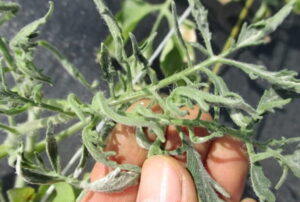

This article contains affiliate links. If you make a purchase using one of these links, I will receive a very small commission at no additional cost to you, and it will help me maintain this website. Rest assured, I only recommend products I actually like!
5. Pests – Upward Leaf Curl
Another cause of leaf roll is insect pests. Some pests, like the pickleworm, curl leaves to create a protective shelter in which they can hide, lay eggs, or pupate. Other pests, like broad mites, inject toxins into leaves causing the tissue to curl or become distorted. Broad mites are the smallest species of mites and are almost invisible to the naked eye.
Effective organic broad mite control includes insecticidal soap and neem oil. You can find natural and cost-effective DIY recipes in this article on how to eliminate spider mites.
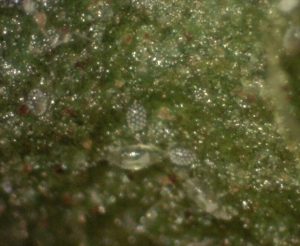
Aphids are another common pest that attacks tomato plants. They feed on the sap found in stems and leaves. These small but destructive insects stunt plant growth, cause leaves to curl and reduce fruit yield. You can learn more about them and how to treat them organically in this helpful article.
6. Nutritional Concerns
While less common than the above causes, micronutrient deficiency can be a source of leaf curl. Micronutrients like molybdenum and boron can be depleted over time. The deficiency is also sometimes seen in lesser quality soils.
Before treating for any nutrient or micronutrient deficiency, rule out the previous possible causes. If you suspect a micronutrient deficiency, add organic fertilizer, compost, or azomite, all of which contain trace minerals.
Leaf curl is not caused by calcium or magnesium deficiency until the very end stages of decline. Instead, calcium deficiency is characterized by blossom end rot in the earlier stages, while magnesium deficiency causes leaf edges to turn yellow and look scorched.
Another possible cause of leaf roll is an excess of nitrogen. Additional signs will be thicker leaves that are dark green. Too much nitrogen in the soil can be a result of applying animal manure that has not been fully composted. You can use a simple and inexpensive soil test kit like this one to check NPK (nitrogen, phosphorus, and potassium) levels. Excessive nitrogen, however, is less likely to be the cause. It is much more likely that one of the other reasons listed above is the culprit.
7. Curly Top Virus
Curly top virus is the most common of the tomato leaf viruses. It is observed in new leaf growth which will appear twisted, spindly, or curly. Growth may be stunted, or it may try to produce additional side shoots or suckers to compensate for the diseased tips.
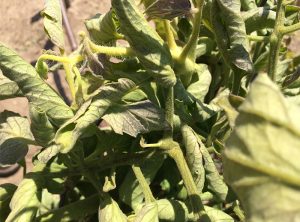
There is a good chance that fruit that is near maturity will continue to ripen if left on the plant, and it will be edible. However, younger fruit may be stunted and not ripen. Seeds from ripened fruit will not be affected by the virus.
The virus is often transmitted by leafhoppers who carry the virus in their saliva. Thankfully, it is not transmitted when an infected plant touches an uninfected one.
Because curly top virus is a systemic disease, it will eventually kill the plant. There is no treatment. Instead, prevent infection by controlling leafhopper populations. Learn how to treat leafhoppers organically in this helpful article.
8. Tomato Mosaic Virus
Tomato mosaic virus, as well as cucumber mosaic virus and tobacco mosaic virus, can negatively impact tomato crops. Younger plants will be stunted, and their leaves will curl upwards. In addition, leaves will be mottled and wilting. The fruit will look puckered and brown inside.
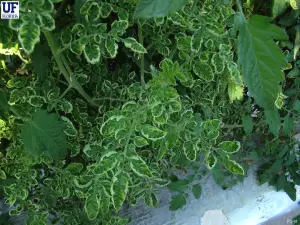
The viruses are spread to plants primarily by gardeners either through contact with contaminated tools, hands, or gloves. There is no treatment. To prevent further spread, diseased plants should be pulled and thrown away. Do not compost them. Next season, do not plant tomatoes in the same area because the viruses can live in the soil for one to two years. Choose a new location and plant resistant varieties
9. Tomato Yellow Leaf Curl Virus
Tomato yellow leaf curl virus can cause both upward and downward leaf curling. Young leaves, in particular, will yellow in between the veins. Growth will be stunted, and you may also notice that flowers and fruit either do not develop or they drop off. The virus is spread by Silverleaf whiteflies. You can learn more about this whiteflies and how to get rid of them in this helpful article.
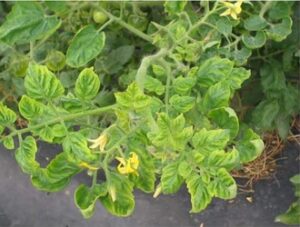
There is no cure for this virus once the plant is infected. If whiteflies are present, you may want to remove the plant by inverting a trash bag over it to trap them. Then cut the plant off at soil level or uproot it, tie the bag, and throw it away. This will reduce the whitefly population and prevent them from infecting other plants. Do not compost the uprooted plant as most compost piles do not maintain high enough temperatures to kill the virus and the whitefly eggs or larvae.
10. Fungal Diseases – Downward Leaf Curl
Another cause of downward curling leaves is fungal diseases like fusarium wilt and Septoria wilt. These fungal infections tend to occur early in the season when temperatures are cooler and conditions are more hospitable to fungal infections.
Unfortunately, there is no treatment for fusarium wilt. Septoria wilt, on the other hand, can be treated by removing diseased leaves and using an organic fungicide like neem oil to keep it from spreading. You can check out this helpful article to learn more about neem oil and to get a DIY recipe.
These fungal diseases are soil-borne. To minimize the chance of your plants contracting them, refrain from using infected soil and plant a bit later in the season when the soil temperature has warmed.
These are the top ten reasons for tomato leaf curl. Remember, leaf curl is not always indicative of a devastating condition. The most common causes can be treated or prevented to ensure that you have a bumper crop each season.
Thank you for reading this article! If you found it helpful, please consider sharing it with others via email and social media!
